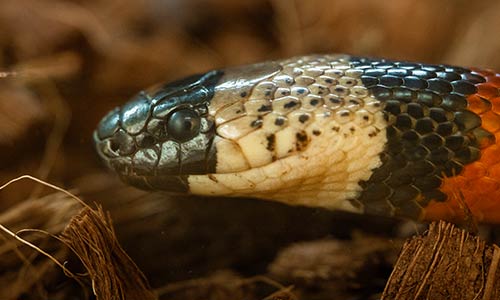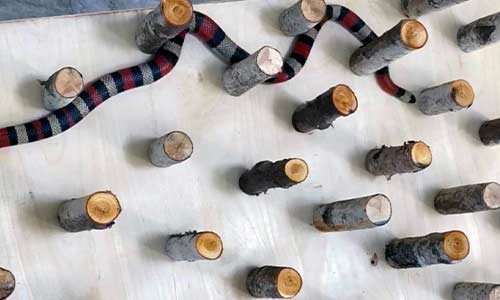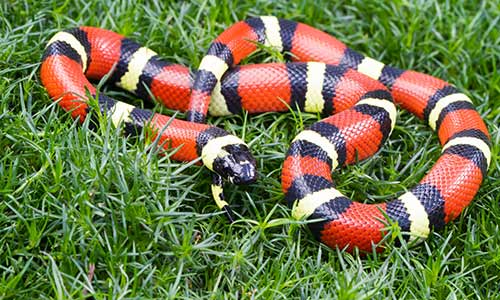Pueblan Milk Snake
Lampropeltis triangulum campbelli
About the Pueblan Milk Snake

Class: Reptilia
Order: Squamata
Family: Colubridae
Genus: Lampropeltis
Species: triangulum campbelli
The Pueblan milk snake is a slender-bodied snake with a striped color pattern of black, yellow and red stripes. These color bands are intended to mimic those of the venomous coral snake, warding off potential predators. Pueblan milk snakes are generally solitary and nocturnal, being most active at night and dusk. On hot days, they will stay under rocks, logs, or in burrows. They are called "Pueblan" snakes because they're native to the Mexican state of Puebla, as well as other dry, arid desert regions throughout Central Mexico.
Pueblan Milk Snake Facts
Appearance:
The pueblan milk snake is a slender-bodied snake with a striped color pattern. Their stripe pattern includes stripes of black, yellow, black, and red, in that order. The color bands on this snake are intended to mimic those of the venomous coral snake, scaring off potential predators. They have a highly sensitive forked tongue and Jacobson’s (or vomeronasal) organ to sense chemicals in the environment. The snake flicks its tongue in and out, capturing odor particles and pressing them against the Jacobson's organ.
Size:
- Length: 2 - 4 feet
Diet:
Mainly rodents, birds, lizards, and other snakes. The snake consumes its prey by constricting it until the blood flow to its heart has ceased, then swallowing it whole. Because of this, milk snakes contribute to rodent control in the rural areas they inhabit.
Reproduction:
These snakes typically breed in the late spring and summer. Females lay an average of two to 14 eggs, usually in rotting wood or beneath rocks and logs where conditions are relatively warm and humid. After the female lays her eggs, she will leave and not provide any parental care. The eggs will hatch after one to two months and each hatchling is only a few inches long when it leaves the egg. They are more brightly colored at birth than the adults, but their color fades as they mature.
Behavior:
The Pueblan milk snake is generally solitary and primarily nocturnal, being most active at night and dusk. On hot days, they will stay under rocks, logs, or in burrows. They spend the winter in communal dens in a state of brumation, which helps them survive the cold temperatures.
Habitat/range:
Dry, arid desert regions throughout Central Mexico. They are native to a number of Mexican states, including Puebla, Morelos, and Oaxaca.
Median Life Expectancy:
Unknown in the wild
Fun Facts:
- These snakes are a species of kingsnake.
- Milk snakes get their name from a folktale that describes a snake sneaking into a barn and drinking the milk from nursing cows.
- Pueblan milk snakes are sometimes called Campbell's milk snakes. They are called "Pueblan" because they are native to Puebla.
You Can Find This Animal in the Treasures of the Sierra Madre
You May Also Like
At Franklin Park Zoo:
At Stone Zoo:







